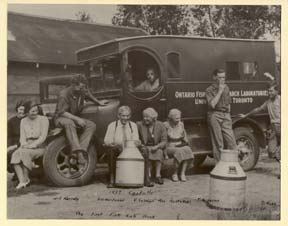
Check the Publications page for access to the historic collection of published work from OFRL
In 1921, research on fisheries and aquatic science in Ontario was organized under the newly created "Ontario Fisheries Research Laboratory" (OFRL) directed by W. Clemens, Department of Biology, University of Toronto. One of the first undergraduates in this group was Bill Harkness, whose project in the summer of 1920 was analyzing growth rates of yellow perch in Lake Erie from scale samples. Following this work, Harkness was invited in 1921 to participate in the first field program of OFRL ~ Lake Nipigon. The Lake Nipigon work offered the opportunity to investigate fish populations in a lake where commercial fishing was operating for only five years. This work ended in 1926.
In 1924, Harkness became the Director of the OFRL only two years after graduating from the University of Toronto. In 1929, he led the of second field site of OFRL located on Frank's Bay, Lake Nipissing, at the French River outlet. It was at the field station on Frank's Bay that a cadre of undergraduates and new graduate students started their careers who would later occupy leading roles in field ecology in Canada. Among the undergrads at the field station were Fred Fry, Bill Ricker and Dennis Chitty. New grad students included Ray Langford.
In 1936, work began on a new field station for OFRL on Lake Opeongo, Algonquin Park. This site would become the permanent field location for OFRL until 1961 when the 'fish lab' at Opeonpo was officially re-dedicated as the Harkness Laboratory of Fisheries Research under the then Ontario Department of Lands and Forests. The lab was named after Bill Harkness to mark his passing in 1960.
The above information is a condensed summary of OFRL history from the book: "Fish and Wildlife: A Memorial to W.J.K. Harkness" edited by J.R. Dymond, 1964 Longman's Canada Ltd, Toronto
